Papers by alessio colombo
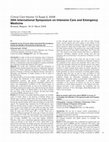
Journal of Neuropathology and Experimental Neurology, 2009
all 10 cities including the rural areas of the province of Kerman. All data were finally analyzed... more all 10 cities including the rural areas of the province of Kerman. All data were finally analyzed by SPSS software (version 11.5). Results On the basis of recorded statistical analysis, the mortality cases of human rabies in the province of Kerman during one decade was 10 persons (eight males and two females). One-half of them (50%) were bitten by dogs and the others (50%) by foxes. Among the reported deaths, 40% were from Kahnooj county (Jiroft region). The reported data indicated that 21,546 persons were bitten by animals during 10 years in the province of Kerman. The mean of age of the people who were bitten by dogs was 24.80 years (SD = ±14.6), while the mean age of the people who were bitten by foxes was 57.25 years (SD = ±1.50). There was a significant difference between the mean age of these two groups of the people (P < 0.05). The most frequent rate of injured people was reported in the age group 10-19 years old and the frequency rate of males (76.00%) was more than females (24.00%). Therefore, there was a statistically significant difference between males and females in this study (P < 0.01). About 60% of all persons that were bitten by animals were from rural areas and 40% of them were from urban areas (P < 0.05). Among the people who were bitten and injured by animals during one decade in the province of Kerman, 85.70% of them were not treated by the rabies prophylaxis treatment regimen. Among all of them who were bitten by animals, 50% were injured through hands and feet, 40%
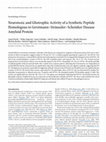
Journal of Neuroscience, 2007
Sträussler-Scheinker (GSS) disease are composed of a fragment of the prion protein (PrP), the N a... more Sträussler-Scheinker (GSS) disease are composed of a fragment of the prion protein (PrP), the N and C termini of which correspond to ragged residues 81-90 and 144 -153. A synthetic peptide spanning the sequence 82-146 (PrP 82-146) polymerizes into protease-resistant fibrils with the tinctorial properties of amyloid. We investigated the biological activity of PrP 82-146 and of two nonamyloidogenic variants of PrP 82-146 with scrambled amino acid sequence 106 -126 or 127-146. Cortical neurons prepared from rat and mouse embryos were chronically exposed to the PrP 82-146 peptides (10 -50 M). PrP 82-146 and the partially scrambled peptides induced neuronal death with a similar dose-response pattern, indicating that neurotoxicity was independent of amyloid fibril formation. Neurotoxicity was significantly reduced by coadministration of an anti-oligomer antibody, suggesting that PrP 82-146 oligomers are primarily responsible for triggering cell death. Neurons from PrP knock-out (Prnp0/0) mice were significantly less sensitive to PrP 82-146 toxicity than neurons expressing PrP. The gliotrophic effect of PrP 82-146 was determined by [methyl-3 H]thymidine incorporation in cultured astrocytes. Treatment with PrP 82-146 stimulated [methyl-3 H]-thymidine uptake 3.5-fold. This activity was significantly less when the 106 -126 or 127-146 regions were disrupted, indicating that PrP 82-146 amyloid activates the gliotrophic response. Prnp0/0 astrocytes were insensitive to the proliferative stimulus of PrP 82-146. These results underline the role of cerebral accumulation of abnormally folded PrP fragments and indicate that cellular PrP governs the pathogenic process.
Alzheimers & Dementia, 2006
similar effects. However ␥-secretase activity was not affected by GSLs in in vitro assays. By bio... more similar effects. However ␥-secretase activity was not affected by GSLs in in vitro assays. By biochemical and cell biological experiments, we demonstrate that the increased levels of cellular GSLs altered the distribution and stability of APP-CTFs. Similar results were also obtained in independent genetic cellular models of GSL storage. On the other hand, GSL deficient cells showed decreased levels of APP-CTFs.

Intensive Care Medicine, 2000
Objectives: To describe the effects of early translaryngeal tracheostomy on intracranial pressure... more Objectives: To describe the effects of early translaryngeal tracheostomy on intracranial pressure (ICP), cerebral perfusion pressure (CPP), and jugular bulb saturation (SjO2); to identify the main mechanisms affecting ICP during tracheostomy; and to evaluate the long-term effects of tracheostomy on tracheal anatomy and function. Design: Prospective, observational, clinical study. Setting: Neurosurgical intensive care unit in a teaching hospital. Patients: 20 patients admitted to the ICU because of head injury, subarachnoid hemorrhage, or brain tumor with a Glasgow Coma Scale less than 8. Interventions: Patients underwent translaryngeal tracheostomy under strict neuromonitoring. Measurements and results: ICP rose significantly (p < 0.05) at the critical time of cannula placement while all other parameters remained stable. At this time five patients suffered intracranial hypertension (ICP > 20 mmHg). In one of them CPP dropped below 60 mmHg. Arterial CO2 tension (PaCO2) did not rise significantly. No other major complications were recorded during the procedures. Three months after tracheostomy normal findings were detected by tracheoscopy in all cases (11 patients could be examined). Conclusions: Translaryngeal tracheostomy, performed in selected patients when the risk of intracranial hypertension was reduced to the minimum, was well tolerated in the majority of cases and did not induce persistent intracranial disorders. However, ICP is affected by tracheostomy, and careful monitoring and patient selection is necessary. At follow-up no severe anatomical or functional damage was detected.
Neurobiology of Disease, 2009
Secretion of Amyloid-beta peptide (Aβ) circulating oligomers and their aggregate forms derived by... more Secretion of Amyloid-beta peptide (Aβ) circulating oligomers and their aggregate forms derived by processing of beta-amyloid precursor protein (APP) are a key event in Alzheimer's disease (AD).
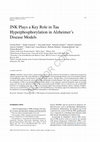
Pharmaceuticals, 2010
Alzheimer's disease (AD) is a major clinical concern, and the search for new molecules to combat ... more Alzheimer's disease (AD) is a major clinical concern, and the search for new molecules to combat disease progression remains important. One of the major hallmarks in AD pathogenesis is the hyperphosphorylation of tau and subsequent formation of neurofibrillary tangles. Several kinases are involved in this process. Amongst them, c-Jun N-terminal kinases (JNKs) are activated in AD brains and are also associated with the development of amyloid plaques. This study was designed to investigate the contribution of JNK in tau hyperphosphorylation and whether it may represent a potential therapeutic target for the fight against AD. The specific inhibition of JNK by the cell permeable peptide D-JNKI-1 led to a reduction of p-tau at S202/T205 and S422, two established target sites of JNK, in rat neuronal cultures and in human fibroblasts cultures. Similarly, D-JNKI-1 reduced p-tau at S202/T205 in an in vivo model of AD (TgCRND8 mice). Our findings support the fundamental role of JNK in the regulation of tau hyperphosphorylation and subsequently in AD pathogenesis.
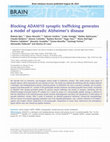
Brain, 2010
We describe here an innovative, non-transgenic animal model of Alzheimer's disease. This model mi... more We describe here an innovative, non-transgenic animal model of Alzheimer's disease. This model mimics early stages of sporadic disease, which represents the vast majority of cases. The model was obtained by interfering with the complex between a disintegrin and metalloproteinase domain containing protein 10 (ADAM10), the main a-secretase candidate, and its partner, synapse-associated protein 97, a protein of the postsynaptic density-membrane associated guanylate kinase family. Association of ADAM10 with synapse-associated protein 97 governs enzyme trafficking and activity at synapses. Interfering with the ADAM10/synapse-associated protein 97 complex for 2 weeks by means of a cell-permeable peptide strategy is sufficient to shift the metabolism of the amyloid precursor protein towards amyloidogenesis and allows the reproduction of initial phases of sporadic Alzheimer's disease. After 2 weeks of treatment, we detected progressive Alzheimer's disease-like neuropathology, with an increase of b-amyloid aggregate production and of tau hyperphosphorylation, and a selective alteration of N-methyl-Daspartic acid receptor subunit composition in the postsynaptic compartment of mouse brain. Behavioural and electrophysiological deficits were also induced by peptide treatment. Keywords: animal models; SAP97; NMDA; synaptopathy; amyloid precursor protein metabolism Abbreviations: ADAM10 = a disintegrin and metalloproteinase domain with protein 10; Ab = b-amyloid peptide; Ala = Tat-Ala ADAM10 709-729 peptide; CTF = carboxy terminal fragment; Pro = Tat-Pro ADAM10 709-729 peptide; SAP97 = synapse-associated protein 97; TIF = Triton-X insoluble fraction Downloaded from 2 | Brain 2010: Page 2 of 13 R. Epis et al. at Università degli Studi di Milano on October 1, 2010 brain.oxfordjournals.org Downloaded from In vivo uncoupling of ADAM10/SAP97 Brain 2010: Page 3 of 13 | 3 at Università degli Studi di Milano on October 1, 2010 brain.oxfordjournals.org Downloaded from 4 | Brain 2010: Page 4 of 13 R. Epis et al. at Università degli Studi di Milano on October 1, 2010 brain.oxfordjournals.org Downloaded from In vivo uncoupling of ADAM10/SAP97 Brain 2010: Page 11 of 13 | 11 at Università degli Studi di Milano on October 1, 2010 brain.oxfordjournals.org Downloaded from In vivo uncoupling of ADAM10/SAP97 Brain 2010: Page 13 of 13 | 13 at Università degli Studi di Milano on October 1, 2010 brain.oxfordjournals.org Downloaded from
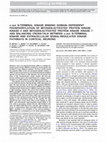
Neuroscience, 2009
against neuronal death in CNS diseases, but the precise features of this neuroprotection remain u... more against neuronal death in CNS diseases, but the precise features of this neuroprotection remain unclear. We here performed cell-free and in vitro experiments for a deeper characterization of D-JNKI1 features in physiological conditions. This peptide works by preventing JNK interaction with its c-Jun N-terminal kinase-binding domain (JBD) dependent targets. We here focused on the two JNK upstream MAPKKs, mitogen-activated protein kinase kinase 4 (MKK4) and mitogenactivated protein kinase kinase 7 (MKK7), because they contain a JBD homology domain. We proved that D-JNKI1 prevents MKK4 and MKK7 activity in cell-free and in vitro experiments: these MAPKK could be considered not only activators but also substrates of JNK. This means that D-JNKI1 can interrupt downstream but also upstream events along the JNK cascade, highlighting a new remarkable feature of this peptide. We also showed the lack of any direct effect of the peptide on p38, MEK1, and extracellular signal-regulated kinase (ERK) in cell free, while in rat primary cortical neurons JNK inhibition activates the MEK1-ERK-Ets1/c-Fos cascade. JNK inhibition induces a compensatory effect and leads to ERK activation via MEK1, resulting in an activation of the survival pathway-(MEK1/ERK) as a consequence of the death pathway-(JNK)
Cell Death and Differentiation, 2007
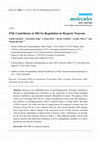
Molecules, 2009
Hypoxia is an established factor of neurodegeneration. Nowadays, attention is directed at underst... more Hypoxia is an established factor of neurodegeneration. Nowadays, attention is directed at understanding how alterations in the expression of stress-related signaling proteins contribute to age dependent neuronal vulnerability to injury. The purpose of this study was to investigate how Hif-1α, a major neuroprotective factor, and JNK signaling, a key pathway in neurodegeneration, relate to hypoxic injury in young (6DIV) and adult (12DIV) neurons. We could show that in young neurons as compared to mature ones, the protective factor Hif-1α is more induced while the stress protein phospho-JNK displays lower basal levels. Indeed, changes in the expression levels of these proteins correlated with increased vulnerability of adult neurons to hypoxic injury. Furthermore, we describe for the first time that treatment with the D-JNKI1, a JNK-inhibiting peptide, rescues adult hypoxic neurons from death and contributes to Hif-1α upregulation, probably via a direct interaction with the Hif-1α protein.
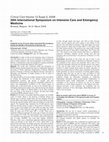
Critical Care, 2008
all 10 cities including the rural areas of the province of Kerman. All data were finally analyzed... more all 10 cities including the rural areas of the province of Kerman. All data were finally analyzed by SPSS software (version 11.5). Results On the basis of recorded statistical analysis, the mortality cases of human rabies in the province of Kerman during one decade was 10 persons (eight males and two females). One-half of them (50%) were bitten by dogs and the others (50%) by foxes. Among the reported deaths, 40% were from Kahnooj county (Jiroft region). The reported data indicated that 21,546 persons were bitten by animals during 10 years in the province of Kerman. The mean of age of the people who were bitten by dogs was 24.80 years (SD = ±14.6), while the mean age of the people who were bitten by foxes was 57.25 years (SD = ±1.50). There was a significant difference between the mean age of these two groups of the people (P < 0.05). The most frequent rate of injured people was reported in the age group 10-19 years old and the frequency rate of males (76.00%) was more than females (24.00%). Therefore, there was a statistically significant difference between males and females in this study (P < 0.01). About 60% of all persons that were bitten by animals were from rural areas and 40% of them were from urban areas (P < 0.05). Among the people who were bitten and injured by animals during one decade in the province of Kerman, 85.70% of them were not treated by the rabies prophylaxis treatment regimen. Among all of them who were bitten by animals, 50% were injured through hands and feet, 40%

Uploads
Papers by alessio colombo